Research on the Arrangement of Additional Source for Large Space Protection of an Active Noise Barrier
Abstract
:1. Introduction
2. Active Noise Barrier
3. Numerical Analysis
3.1. Simulation Model
3.2. Calculation Results
4. Directivity Calculation When the Primary Source Is Located Away from the Barrier and Double Sources
5. Approximate Model for Optimal Location of Additional Source
6. Experimental Results
7. Conclusions
Author Contributions
Funding
Institutional Review Board Statement
Informed Consent Statement
Data Availability Statement
Acknowledgments
Conflicts of Interest
References
- Jarosińska, D.; Héroux, M.È.; Wilkhu, P.; Creswick, J.; Verbeek, J.; Wothge, J.; Paunović, E. Development of the WHO Environmental Noise Guidelines for the European Region: An Introduction. Int. J. Environ. Res. Public Health 2018, 15, 813. [Google Scholar] [CrossRef] [PubMed]
- Kwon, N.; Park, M.; Lee, H.S.; Ahn, J.; Shin, M. Construction Noise Management Using Active Control Techniques. J. Constr. Eng. Manag. 2016, 142, 04016014. [Google Scholar] [CrossRef]
- Lam, B.; Gan, W.S.; Shi, D.; Nishimura, M.; Elliott, S. Ten questions concerning active noise control in the built environment. Build. Environ. 2021, 200, 107928. [Google Scholar] [CrossRef]
- Elrefae, A.G.; Issa Mohsen, A. Full-scale testing and nonlinear finite element analysis of a pioneering fully prefabricated noise barrier wall system. Proc. Meet. Acoust. 2023, 293, 116633. [Google Scholar] [CrossRef]
- Ding, Y. Experimental study on design of near rail noise barrier for Wenzhou surburban railway. J. Railw. Eng. Soc. 2022, 39, 98–104. [Google Scholar]
- Huang, X.; Zou, H.; Qiu, X. Effects of the top edge impedance on sound barrier diffraction. Appl. Sci. 2020, 10, 6042. [Google Scholar] [CrossRef]
- Sohrabi, S.; Gomez, T.P.; Garbi, J.R. Using genetic algorithms to optimize the location of transducers for an active noise barrier. J. Low Freq. Noise Vib. Act. Control 2023. [Google Scholar] [CrossRef]
- Hong, G.; Sun, Y.; Tang, Y.; Yuan, X.; Yang, J.; Jin, Z.; Jia, H. A subwavelength ventilated structure for efficient broadband sound insulation. J. Phys. D-Appl. Phys. 2023, 56, 425302. [Google Scholar] [CrossRef]
- Magliacano, D.; Catapane, G.; Petrone, G.; Verdière, K.; Robin, O. Sound transmission properties of a porous meta-material with periodically embedded Helmholtz resonators. Mech. Adv. Mater. Struct. 2023. [Google Scholar] [CrossRef]
- Li, Z.; Ma, M.; Liu, K.; Jiang, B. Performance of rubber-concrete composite periodic barriers applied in attenuating ground vibrations induced by metro trains. Eng. Struct. 2023, 285, 116027. [Google Scholar] [CrossRef]
- Lee, S.; Park, Y. Circular active noise barrier using theoretical control filter considering interaction between speaker and barrier. Sci. Rep. 2023, 13, 2649. [Google Scholar] [CrossRef] [PubMed]
- Borchi, F.; Carfagni, M.; Martelli, L.; Turchi, A.; Argenti, F. Design and experimental tests of active control barriers for low-frequency stationary noise reduction in urban outdoor environment. Appl. Acoust. 2016, 114, 125–135. [Google Scholar] [CrossRef]
- Wang, S.; Tao, J.; Qiu, X.; Pan, J. A boundary error sensing arrangement for virtual sound barriers to reduce noise radiation through openings. J. Acoust. Soc. Am. 2019, 145, 3695–3702. [Google Scholar] [CrossRef] [PubMed]
- Im, S.; Kim, S.; Woo, S.; Jang, I.; Han, T.; Hwang, U.; Lee, M. Deep learning-assisted active noise control in a time-varying environment. J. Mech. Sci. Technol. 2023, 37, 1189–1196. [Google Scholar] [CrossRef]
- Chen, W.; Pu, H.; Qiu, X. A compound secondary source for active noise radiation control. Appl. Acoust. 2010, 71, 101–106. [Google Scholar] [CrossRef]
- Tan, L.; Jiang, J. Active control of impulsive noise using a nonlinear companding function. Mech. Syst. Signal Process. 2015, 58–59, 29–40. [Google Scholar] [CrossRef]
- Fan, R.; Su, Z.; Cheng, L. Modeling, analysis, and validation of an active T-shaped noise barrier. J. Acoust. Soc. Am. 2013, 134, 1990–2003. [Google Scholar] [CrossRef]
- Ntumy, E.A.; Utyuzhnikov, S.V. Active sound control in 3D bounded regions. Wave Motion 2014, 51, 284–295. [Google Scholar] [CrossRef]
- Sohrabi, S.; Pàmies Gómez, T.; Romeu Garbí, J. Proper location of the transducers for an active noise barrier. J. Vib. Control 2023, 29, 2290–2300. [Google Scholar] [CrossRef]
- Hart, C.R.; Lau, S.K. Active noise control with linear control source and sensor arrays for a noise barrier. J. Sound Vib. 2012, 331, 15–26. [Google Scholar] [CrossRef]
- Niu, F.; Zou, H.; Qiu, X.; Wu, M. Error sensor location optimization for active soft edge noise barrier. J. Sound Vib. 2007, 299, 409–417. [Google Scholar] [CrossRef]
- Huang, X.; Zou, H.; Qiu, X. A preliminary study on the performance of indoor active noise barriers based on 2D simulations. Build. Environ. 2015, 94, 891–899. [Google Scholar] [CrossRef]
- Chen, W.; Rao, W.; Min, H.; Qiu, X. An active noise barrier with unidirectional secondary sources. Appl. Acoust. 2011, 72, 969–974. [Google Scholar] [CrossRef]
- Lee, H.M.; Wang, Z.; Lim, K.M.; Lee, H.P. A Review of Active Noise Control Applications on Noise Barrier in Three-Dimensional/Open Space: Myths and Challenges. Fluct. Noise Lett. 2019, 18, 1930002. [Google Scholar] [CrossRef]
- HJ/T 90-2004; Norm on Acoustics Design and Measurement of Noise Barriers. State Environmental Protection Administration: Beijing, China, 2004.

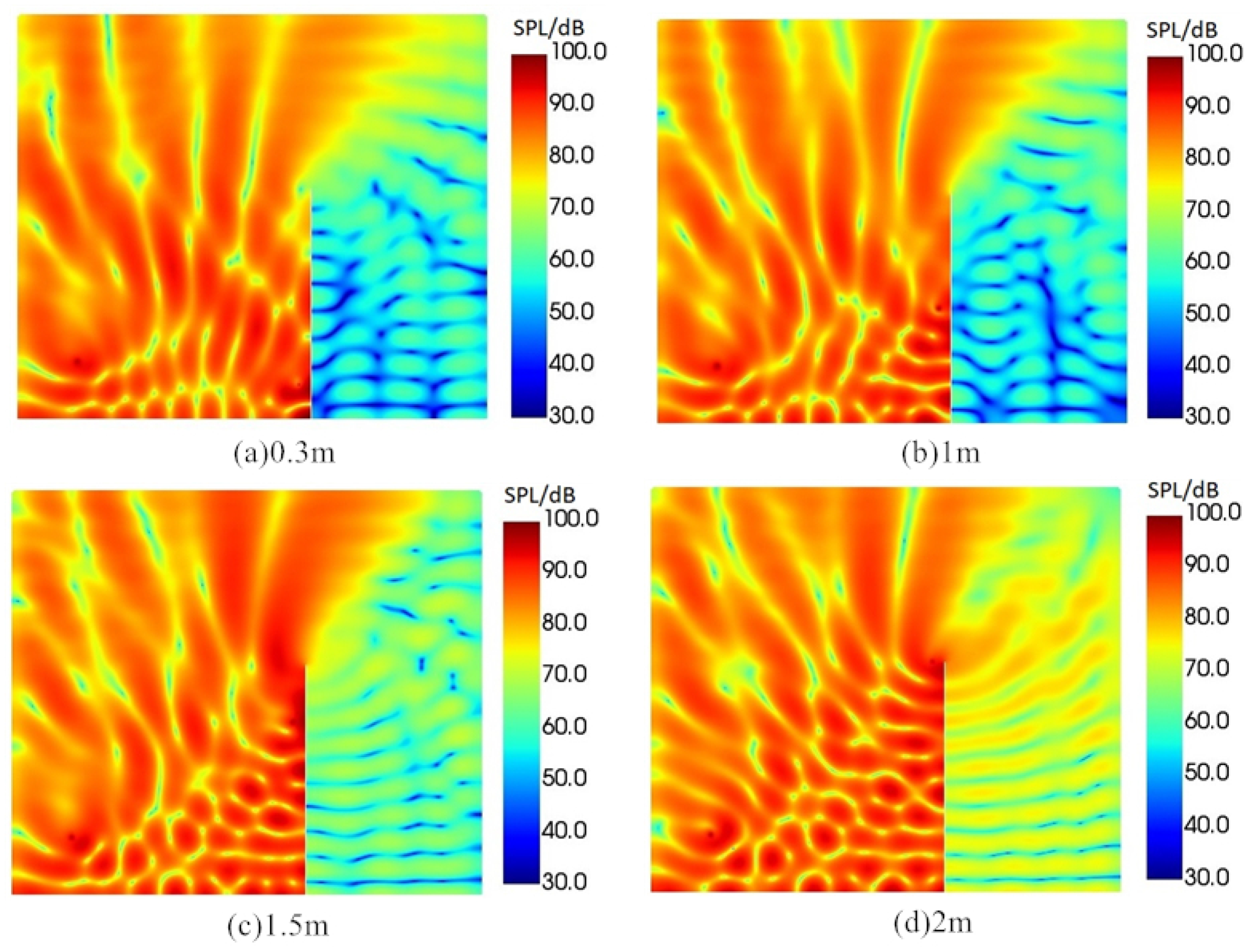

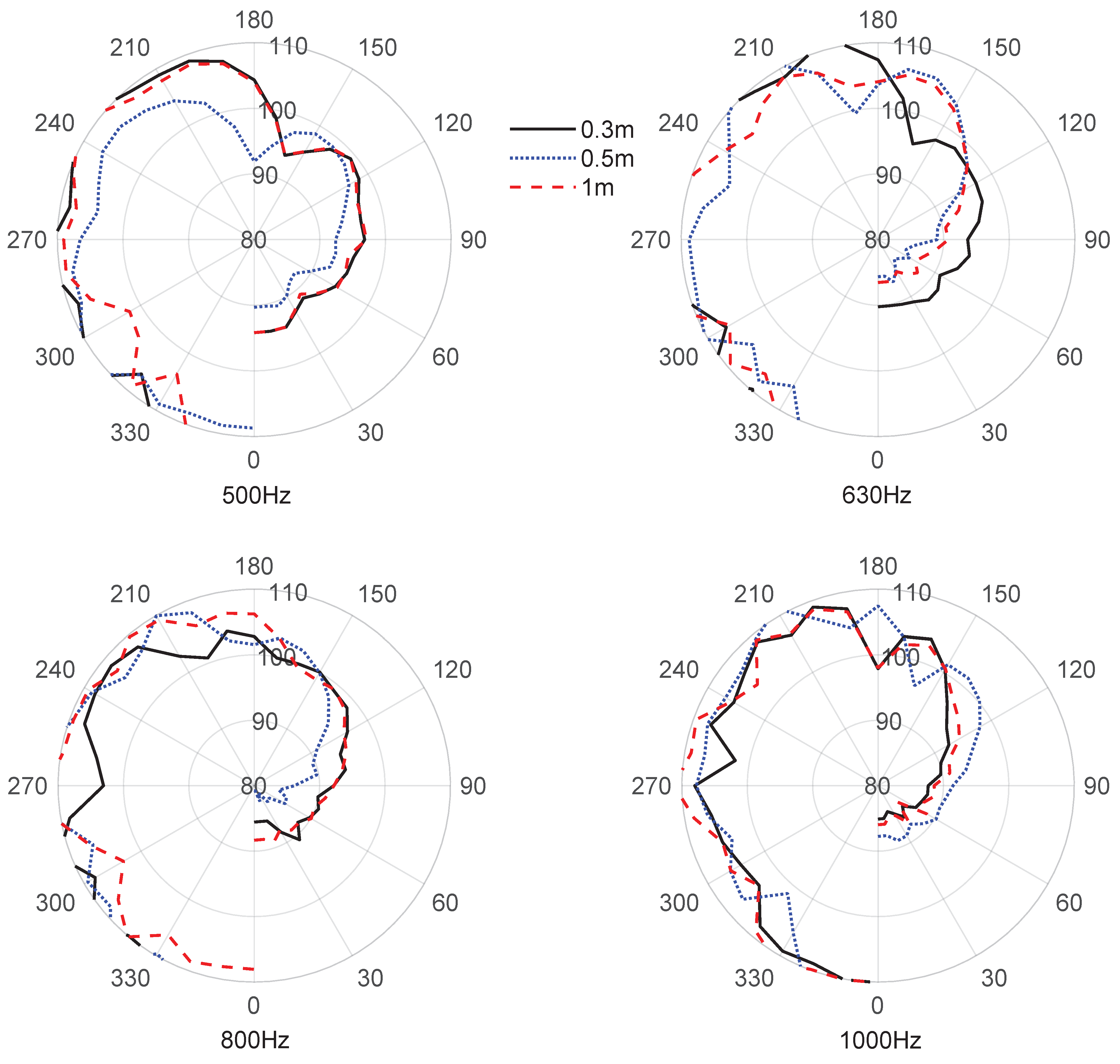

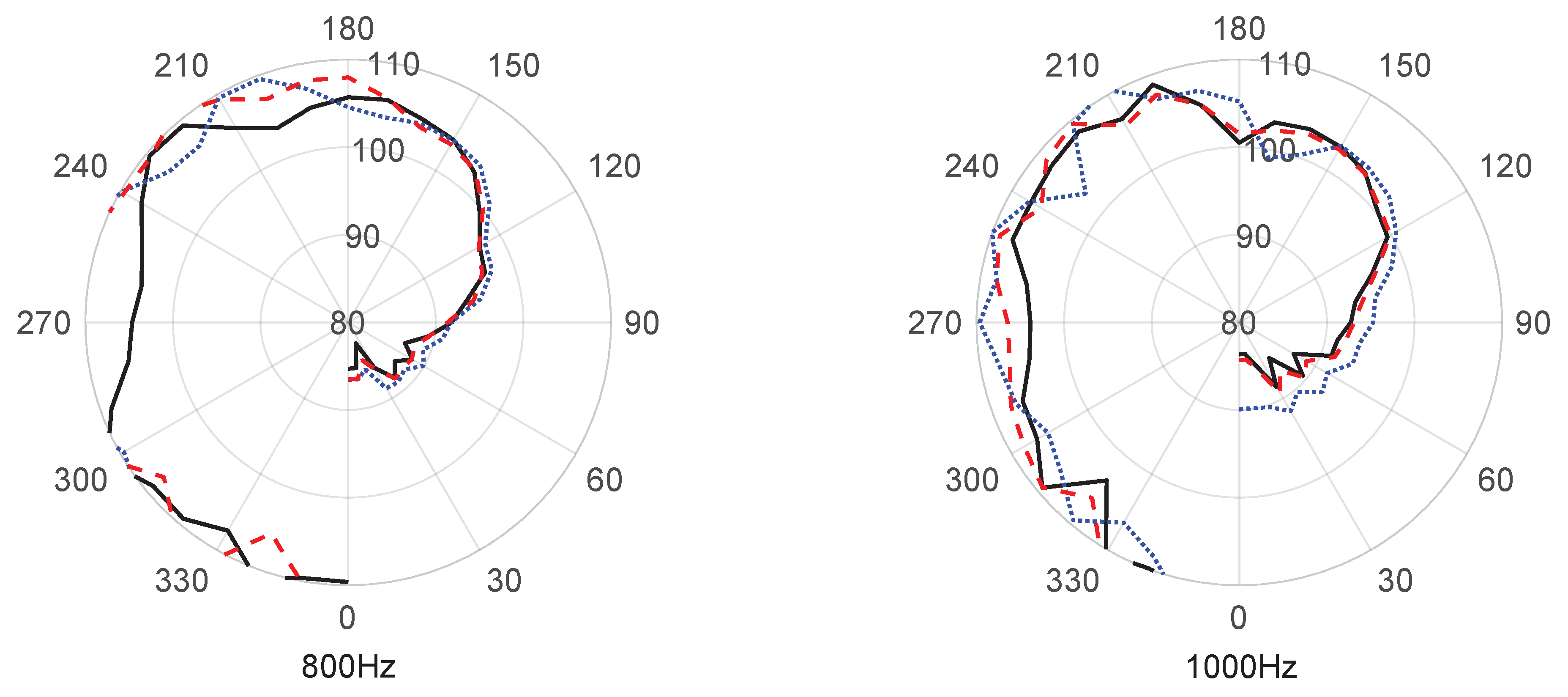



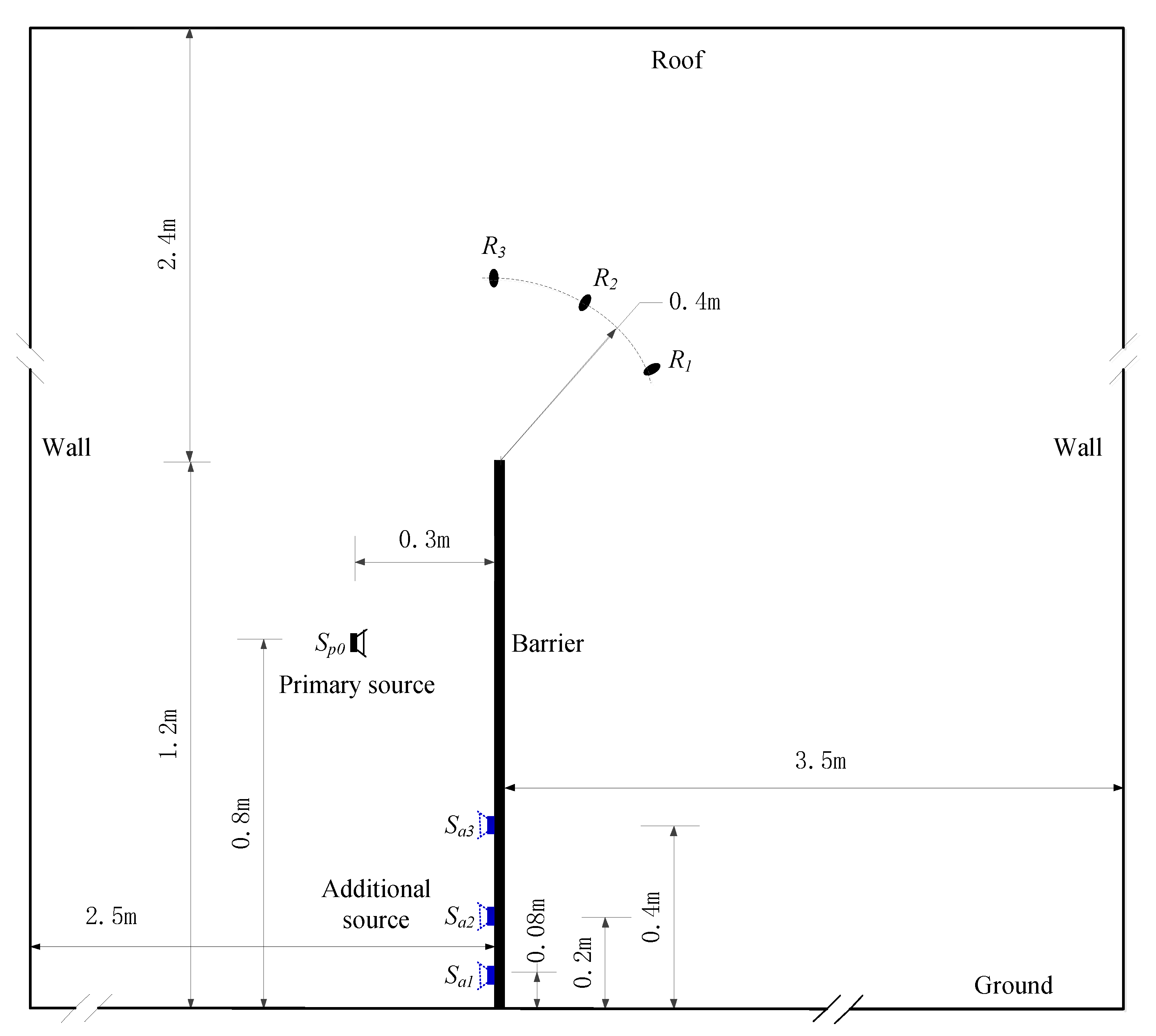
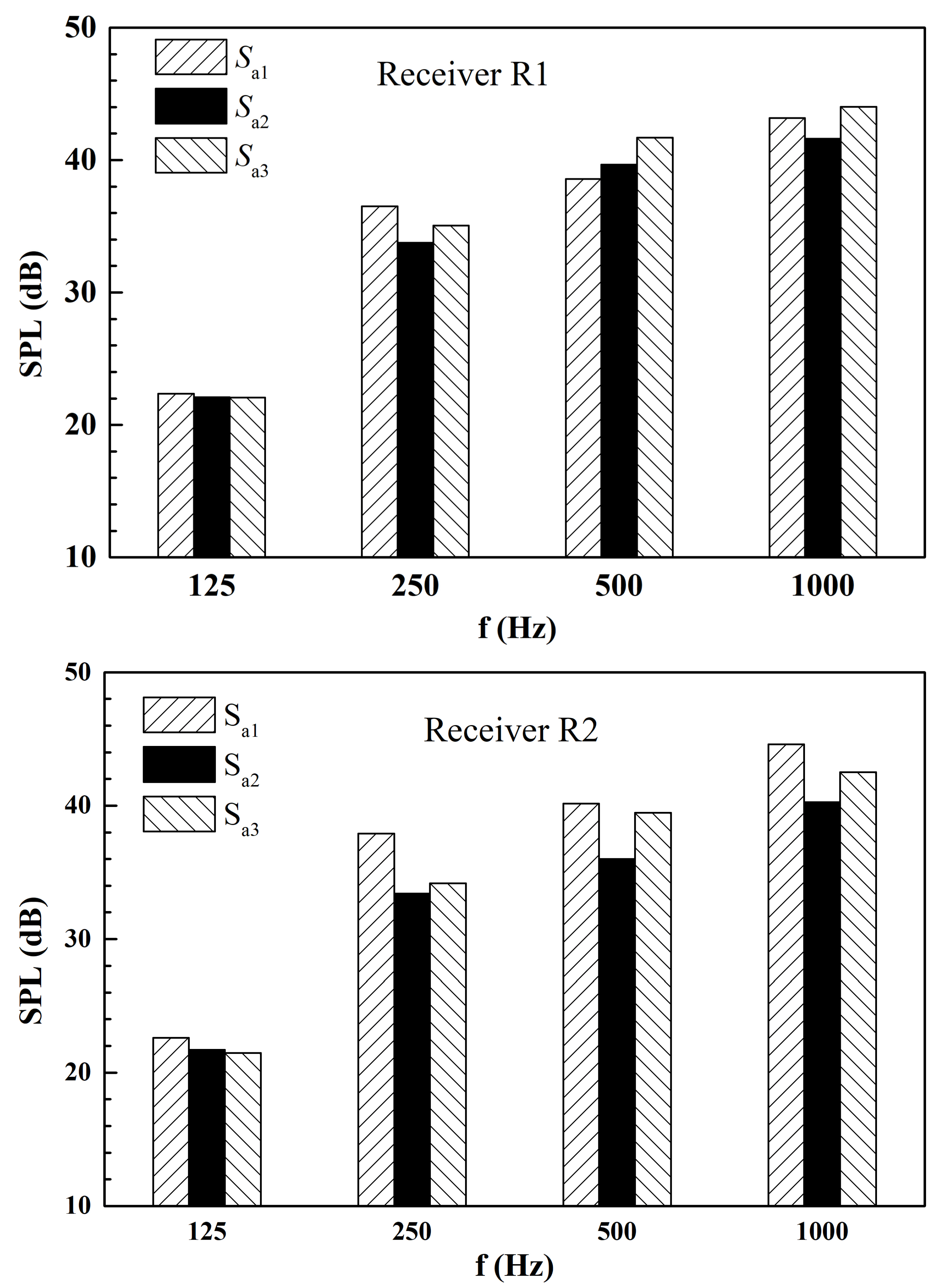
| Frequency\Location | 0.3 m | 0.5 m | 1 m |
|---|---|---|---|
| 500 Hz | • | ||
| 630 Hz | • | ||
| 800 Hz | • | • | |
| 1000 Hz | • | • |
| Group\Receiver | R1 (dBA) | R2 (dBA) | R3 (dBA) |
|---|---|---|---|
| first | 55.52 | 57.73 | 52.63 |
| second | 54.56 | 52.78 | 51.78 |
| third | 57.64 | 54.88 | 53.58 |
Disclaimer/Publisher’s Note: The statements, opinions and data contained in all publications are solely those of the individual author(s) and contributor(s) and not of MDPI and/or the editor(s). MDPI and/or the editor(s) disclaim responsibility for any injury to people or property resulting from any ideas, methods, instructions or products referred to in the content. |
© 2024 by the authors. Licensee MDPI, Basel, Switzerland. This article is an open access article distributed under the terms and conditions of the Creative Commons Attribution (CC BY) license (https://creativecommons.org/licenses/by/4.0/).
Share and Cite
Wang, Y.; Chang, Z.; Chen, G.; Liu, J. Research on the Arrangement of Additional Source for Large Space Protection of an Active Noise Barrier. Appl. Sci. 2024, 14, 885. https://doi.org/10.3390/app14020885
Wang Y, Chang Z, Chen G, Liu J. Research on the Arrangement of Additional Source for Large Space Protection of an Active Noise Barrier. Applied Sciences. 2024; 14(2):885. https://doi.org/10.3390/app14020885
Chicago/Turabian StyleWang, Yanpeng, Zhibo Chang, Guoqiang Chen, and Jiahao Liu. 2024. "Research on the Arrangement of Additional Source for Large Space Protection of an Active Noise Barrier" Applied Sciences 14, no. 2: 885. https://doi.org/10.3390/app14020885





